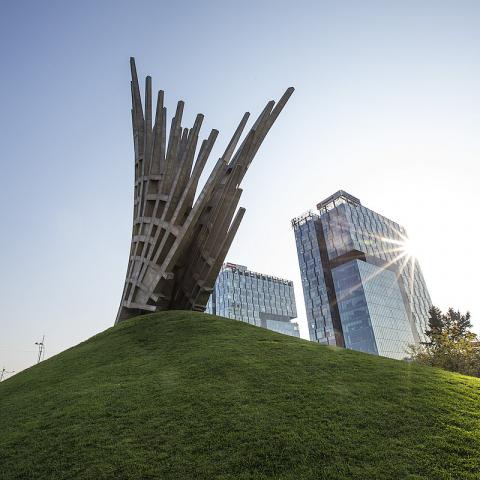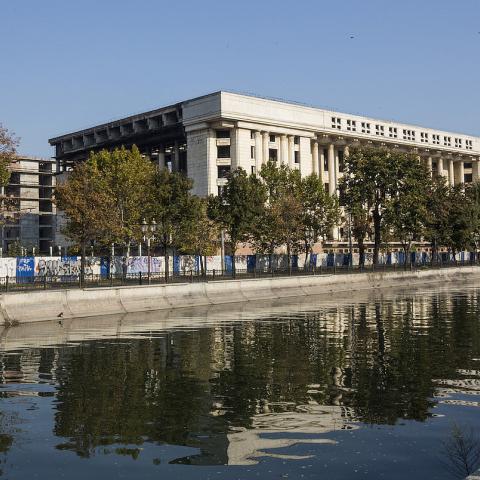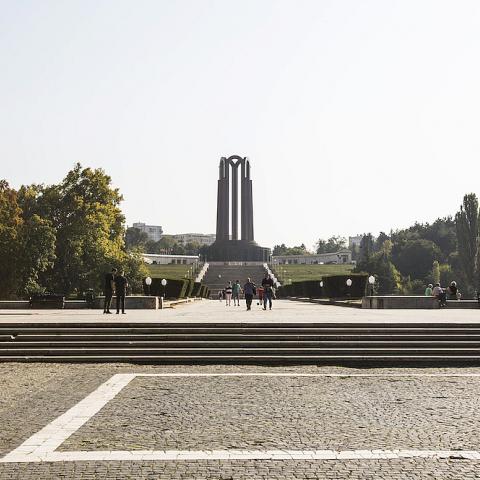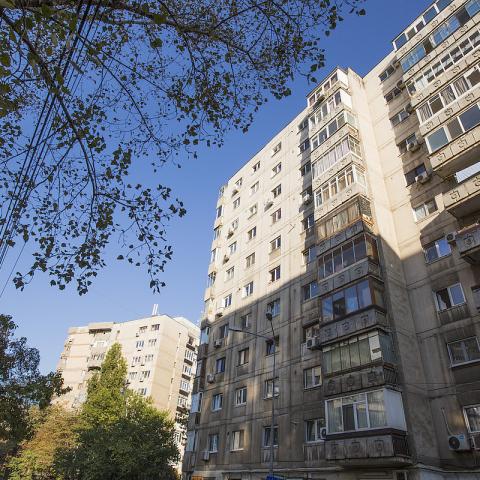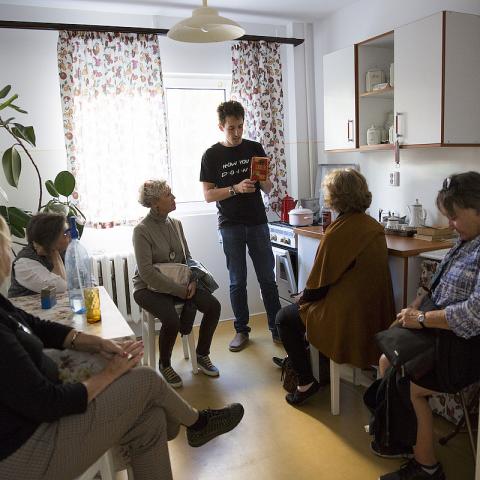"Destination: Bucharest" – Tracing the marks of the communist era in the Capital city
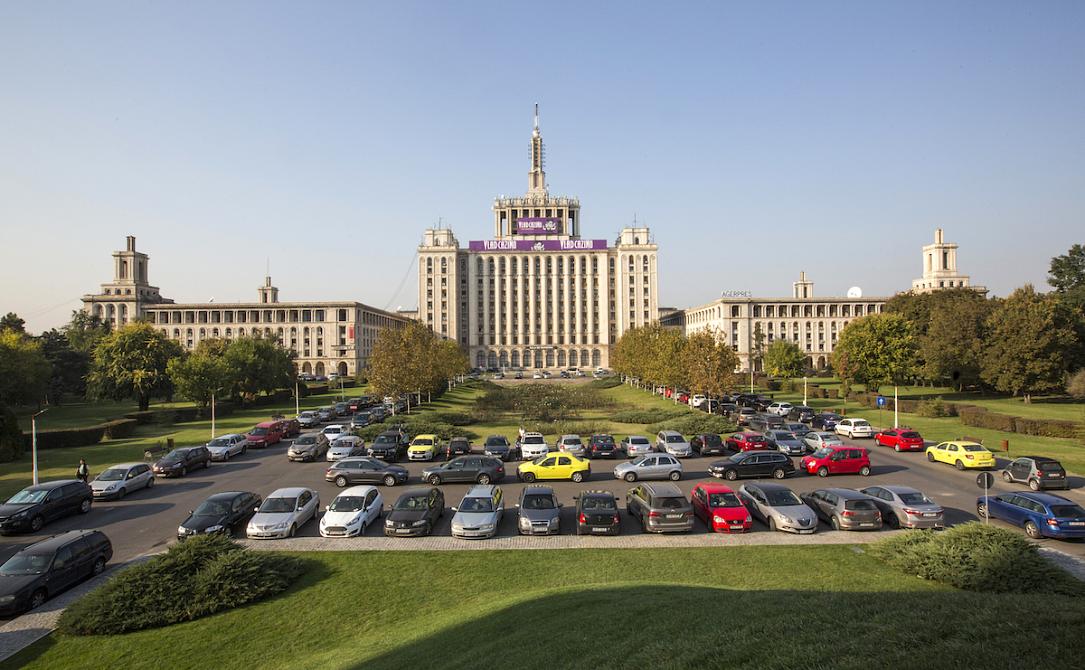
Bucharest has many buildings and monuments made during the communist period or associated with it, all standing testimony to an era when the regime that was in power asserted its importance by choosing a certain architectural style. Let’s have a walk and discover buildings and places in Bucharest that will help understand Romania’s communist period.
Tracing the marks of the communist era in Bucharest takes one from the north part of the city – the former Casa Scânteii building – to downtown, with several representative buildings for the era, then east, to the Militari neigborhood – a typical one of blocks of flats built during communism.
We start here, in the Militari neighborhood, which was created after the houses in the commune of the same name were demolished. It is located close to a subway station, the pride of the urban infrastructure during the Golden Era – the name given by the propaganda machine to the 80s.
The blocks, built to host as many inhabitants as possible, carry today the mark of the apartment owners’ individual initiatives to renovate and beautify them, overcoming the spirit of uniformity that is associated with them. The double glazed windows stand next to ones that keep the original woodwork, and the balconies are decorated with pots of flowers or, alternatively, are used as storage spaces where a variety of items are piled up one over the other.
In a block here, with a small garden in front, we discover the Ferestroika Museum. We hope to understand here parts of how life was like during communism.
Upon entering, one feels as if they’ve just experienced time travel: you enter a domestic space that keeps unaltered, in its rooms, the details of daily life in communist Romania, with all its limitations, shortages, but also some of its joys.
From the entrance hallway, lit by the vintage neon lamps, we enter into the kitchen facing the garden and the front alley, where, if one stays a little longer, they can almost listen to the conversations of those who keep their apartment windows open. The private space can easily turn into a public one and during communism this could have proven risky, depending on what you were discussing and who was listening.
The kitchen was an important room because an additional heat source was found here, namely the cooker stove. It wasn’t very warm inside communist-era apartments and if one visits the museum during a chilly day, it can experience the thermic ambiance of the era. At a time when the radiators were at best lukewarm, if the gas pressure allowed for it, the cooker stove could be used for heating. Often, this wasn’t the case and simple things such as making a coffee or tea proved unattainable. This is why, visitors will spot inside the apartment two electric hot plates one of which could be used, in extremis, for heating food, as long as there was electricity. This wasn’t constantly available either and a gas lamp is stored in the kitchen, showing the need for lighting alternatives. One of the English-speaking tourists visiting the museum asks if there were people who benefited from having electricity all the time and we find out about the exceptions made in the case of the members of the nomenclature and how, on certain streets of the capital, the power was never cut off.
On the kitchen table we find a siphon bottle and visitors can try a glass of Laurul syrup, a local brand with a history going back to 1940. We are also invited to have a cup of chicory coffee. What is today a bio option, was one of the few alternatives 30 - 40 years ago. Coffee wasn’t a readily available product, as imports had been severely limited, and when it was available it had a small coffee content, having been mixed with chickpeas or oats. The mix was nicknamed, ironically, nechezol, a term derived from the onomatopoeia that mimics the sound made by a horse, since oats were used as fodder for them.
Also in the kitchen we find the food ration cards. The cards were dispensed for several basic food items and one needed a well-crafted strategy and a network of acquaintances to obtain food. If you wanted to buy a bottle of milk and yoghurt you needed to wake up very early and queue. If another queue, for a different product, formed at the same time, you could leave a chair there to mark your presence in the second line.
Today we worry about the environmental impact of the single-use plastic bags used in stores. Thirty years ago, the major concern was that that there was not much to buy. A canvas bad hanging by the radiator – the fabric has nothing to do with contemporary sustainability standards – reminds visitors of how important it was to always have it with you. One never knew when stores might receive goods or when they could trade products with someone else.
The storage closet hosts various objects and replacement parts for appliances and devices in the house. The “You never know when you might need it” mentality is present here as well: the objects kept could be exchanged for others, when in need, or for services, depending on everyone’s skills.
The child’s room, furnished in a simple way, is where we encounter many of the ideological themes of the times. The pioneer clothing, hard to keep impeccable when running hot water wasn’t a constant; the school schedule, showing Saturday as a school day; and a brochure showing Mickey Mouse, the cartoon character created in the United States, fighting against the bourgeoisie. On top of the wardrobe, next to the suitcases stored there, we find a plastic banana and orange. The two fruits were rare occurrences in Romanians’ homes during communist times and were often kept to be eaten as a treat during the winter holidays.
In the bedroom, we find out when spare time could mean for women and how knitting was used as a way of standing out, at a time when the clothing items available for purchase were not that varied. With a bit of creativity and help from a book of patterns, like the one displayed in the bedroom, one could have a unique look.
In the bathroom we find some of the well-known brands of the time – Doina toothpaste, the Cheia soap and the toilet paper of the time, another product that could require queuing – as well as the items needed for daily shaving. Wearing long hair for men or a beard were most often forbidden and they needed to be trimmed regularly.
Back in the living room, among trinkets and knitted laces, we are invited to taste the sweets of the time: a cake and doughnuts. The latter seem a simple dessert, but when one finds how hard to find flour, cooking oil and sugar were, they became much more appreciated. Also here, we discover some of the entertainment options of the time: reading – a bookcase stands against one wall, listening to the radio – the official one, or, furtively, radio Free Europe, and watching TV, a few hours a day as the broadcast time was set, long enough to find out about the achievements of the country’s “beloved leaders” – as the official propaganda called them. The lucky ones had a videocassette recorder (VCR), attached to their black-and-white TV set, where they could watch, for instance, a recording of The Terminator film, where the same voice dubbed all the characters.
For a few moments we contemplate the images on the TV screen. Arnold Schwarzenegger’s character is eliminating his opponents efficiently and utters short lines, rendered in Romanian by the easily recognizable voice of translator Irina Margareta Nistor. The effort to keep up to date with US films and the subversive act of watching them, often in a larger group of friends, are a piece of 1980s life in Romania, preserved today in an apartment in Militari neighborhood.
Communist landmarks in Bucharest
When it comes to the architecture of the communist period, Bucharest has several buildings and monuments to add to the to-visit list by those who want to learn more about the period.
Casa Scânteii
In the northern part of the capital, close to the Regele Mihai I Park, Casa Scânteii was built during the 1950s. It was called Casa Scânteii because it hosted the Scânteia newspaper, the official outlet of the Romanian Communist Party. After 1989, Casa Scânteii became known as Casa Presei Libere (The House of Free Press), marking the fall of the communist regime.
A statue of Lenin was set up in front of Casa Scânteii in 1960, underlining even more the soviet influence. In 1990, it was brought down and stored in Mogoșoaia. At the end of 2015, on the place of the statue, a new monument, called Aripi (Wings), was set up. Officially inaugurated in 2015, it is dedicated to the memory of the anti-communist resistence.
Casa Radio
Close to the University Hospital, on the bank of the Dâmbovița river, Casa Radio is one of the architectonic ghosts that carry the label of the communist vision on how the city should look like. The construction of the building started in 1986, on the place taken by a racecourse. The building was meant to serve as the headquarters of the National Museum of History of the Socialist Republic of Romania. It was inaugurated before it was finished, when only the façade was ready, so that Nicolae Ceauşescu could watch the August 23, 1989 parade from the building’s balcony. It was the last August 23 event the dictator attended, seeing the army, the pioneers and well-known athletes parading the occasion. The building is unfinished and is part of a future private retail galleria.
The Mausoleum in Carol Park
Located on the Filaretului Hill, the structure used to be called The Monument of the Heroes of the Fight for the Freedom of the People, the Country, for Socialism. In order for it to be set up, the Tomb of the Unknown Solider, inaugurated in 1923 in Carol Park, was moved at the Mărăşeşti Mausoleum (Focşani – Adjud). The 48-meter tall monument was inaugurated in December 1963, and the crypts of several important personalities of local communism were placed at its base. Among them were Petru Groza, a prime minister in the first communist governments of Romania and whose name is linked to the abdication of King Mihai, Ana Pauker, a foreign affairs minister, and Gheorghe Gheorghiu-Dej, a prime minister and then president of the State Council of the Popular Republic of Romania (1961-1965). After 1989, the remains were moved to other cemeteries. In 1991, the Tomb of the Unknown Soldier was brought back to Carol Park and set up at the park entrance end of the alley leading up to the Mausoleum, where the grave of Petru Groza was still found at the time. In 2006, the Tomb of the Unknown Soldier was moved back to its initial place, on the esplanade in front of the Mausoleum, named today the Memorial of the Heroes of the Nation.
The former HQ of the Central Committee of the Romanian Communist Party
The building located in Revoluției Square was built before the communist regime came into power but it was used for a long time as the HQ of the Central Committee (CC) of the Romanian Communist Party (PCR), the place where the meetings of the government and of the executive political bureau were held. From the balcony of the building, Nicolae Ceaușescu delivered his last speech, on December 21 1989, trying to pacify the people who had rebelled following the events in Timișoara. Later, the helicopter carrying the Ceaușescus took off from the rooftop of the building, as the two were trying to flee from the revolution that had emerged in the capital. The building currently houses the Ministry of Internal Affairs.
Sala Palatului
Close to the CC HQ is Sala Palatului, known today as a concert hall. During the communist time, the building hosted the congresses of PCR. It was built between 1959 and 1960, during the regime of Gheorghe Gheorghiu-Dej, with a capacity of 3,150 seats. In 1982, Nicolae Ceaușescu decided to increase its capacity to over 4,000 seats.
To keep in mind:
An appointment is needed to be able to visit Ferestroika. More details are available here.
Useful:
The communist period started in Romania in 1945, after World War II. After King Michael I of Romania was forced to abdicate at the end of 1947, a dictatorial regime started in Romania. During this period, the country had 5 leaders, named President of the Great National Union or President of the State Council. The Ceaușescu era started in 1967, when Nicolae Ceaușescu became President of the State Council. From 1974, he became president of the Romanian Socialist Republic. He was the longest – lived communist leader. In 1989, after 25 years at the helm of the country, he was overthrown from power following the Revolution in December 1989.
This text is part of a project under the program of promoting the touristic heritage "Destination: Bucharest", carried out by the Bucharest City Hall through the Public Monuments and Touristic Heritage Administration (AMPT).








